Though universally celebrated for its orchestral effects, the "Queen Mab" Scherzo from Berlioz's Romeo and Juliet has otherwise attracted little attention in the literature on Berlioz. On the contrary, the airy wit of Berlioz's scoring has been understandably regarded as the raison d'être of the Scherzo, together, of course, with its traditional symphonic role as a dance-like third movement.1 Once we probe beneath the surface of the orchestration, however, this movement raises a number of questions concerning the scope and nature of Berlioz's aesthetic aims. Was Berlioz's programmatic intent more precise than that of painting a generalized portrait of the miniature fairy queen? Does his orchestration serve more than just an evocative purpose in the overall scheme of this movement? Given its function as a dance movement, how is the Scherzo organized? Does Berlioz follow some kind of Scherzo-Trio-Scherzo formula? The following analytical essay will attempt to answer these three interrelated questions by exploring the confluence of program and sonority in this movement.
It is generally acknowledged that the Prologue to Berlioz's Romeo and Juliet affords the listener direct access to his musical aims during the rest of the symphony. Thus, the Scherzetto of the Prologue, for example, prefigures several central and rather obvious features of the "Queen Mab" Scherzo: its delicate orchestral web; its F-major tonic; fragments of its main theme; and even its 3-8 surface rhythm.2
Example 1. Berlioz, Romeo and Juliet, Scherzetto from the Prologue, mm. 40-47. Orchestral, harmonic, melodic, and rhythmic foreshadowing of the "Queen Mab" Scherzo.
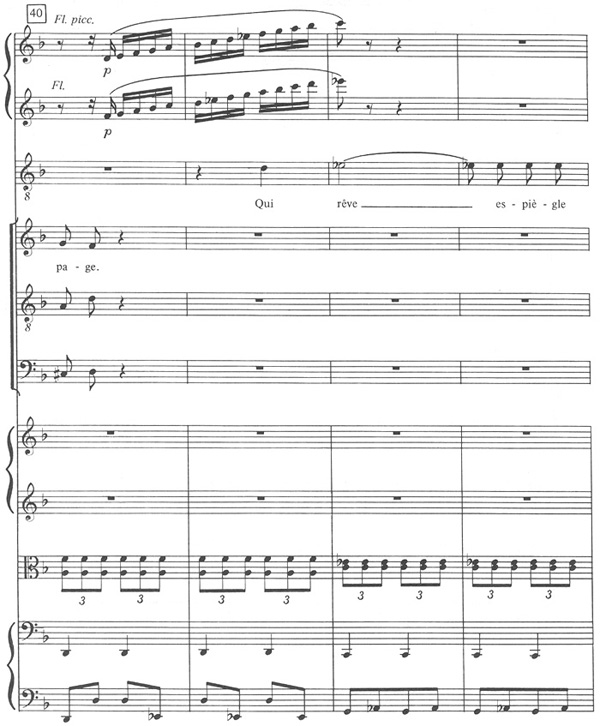
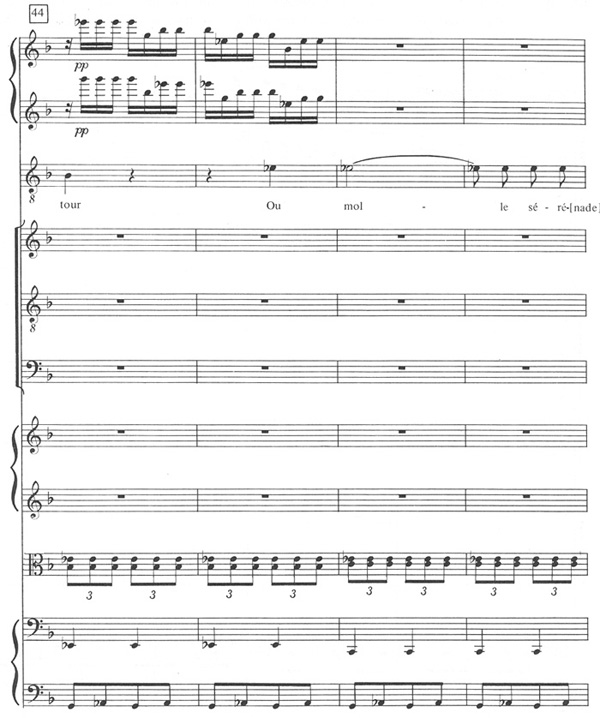
The Scherzetto also contains, however, structural references to the later movement, insofar as its text suggests a possible architectural blueprint for the Scherzo to come. This hidden formal agenda becomes immediately apparent when we compare Shakespeare's original description of Queen Mab (I.iv) with the text of Emile Deschamps, Berlioz's librettist.3
Example 2. A comparison of Shakespeare's and Berlioz's texts. 4
(Shakespeare)
Mercutio:
O then I see Queen Mab hath been with you:
She is the Fairies' midwife, and she comes
In shape no bigger than an agate-stone,
On the forefinger of an alderman,
Drawn with a team of little atomies,
Over men's noses as they lie asleep:
Her waggon-spokes made of long spinners' legs:
The cover, of the wings of grasshoppers,
Her traces of the smallest spider's web,
Her collars of the moonshine's watery beams,
Her whip of cricket's bone, the lash of film,
Her waggoner, a small grey-coated gnat,
Not half so big as a round little worm,
Prick'd from the lazy finger of a maid.
Her chariot is an empty hazel-nut,
Made by the joiner squirrel or old grub,
Time out o' mind, the Fairies' coachmakers:
And in this state she gallops night by night,
Through lovers' brains, and then they dream of love,
On courtiers' knees, that dream on court'sies straight,
O'er lawyers' fingers who straight dream on fees,
O'er ladies' lips who straight on kisses dream,
Which oft the angry Mab with blisters plagues,
Because their breaths with sweetmeats tainted are.
Sometimes she gallops o'er a courtier's nose,
And then dreams he of smelling out a suit:
And sometime comes she with a tithe-pig's tail,
Tickling a parson's nose as a' lies asleep,
Then he dreams of another benefice.
Sometime she driveth o'er a soldier's neck,
And then dreams he of cutting foreign throats,
Of breaches, ambuscadoes, Spanish blades:
Of healths five fadom deep, and then anon
Drums in his ear, at which he starts and wakes,
And being thus frighted, swears a prayer or two
And sleeps again: this is that very Mab
That plats the manes of horses in the night:
And bakes the elf-locks in foul sluttish hairs,
Which once untangled, much misfortune bodes.
This is the hag, when maids like on their backs,
That presses them and learns them first to bear,
Making them women of good carriage:
This is she.
(Berlioz)
Mab, that tiny fairy, so light and so wary.
Her waggon's cut from a hazelnut.
And Master Squirrel was the cartwright,
The traces from the smallest spider's web are wrought
And in this state the fay on the moon's silver ray,
She gallops night by night, thro' lovers' brains and haunts them.
They dream on court'sies straight,
Of sweetest serenade,
Beneath the stars' soft silv'ry light.
Then her mad ride she doth continue
Hastes away nor tarries nor bides
O'er a soldier's neck oft she rides.
And then he dreams of battle,
Where swords 'gainst helmets rattle,
Beat of drums, bugle calling
Then he wakes and glares around,
Swears he heard the trumpet's sound, then turns him o'er
And sleeps until the dawn of morning.
Queen Mab, 'tis she, whose gambols caused all this uproar.
'Tis she again in dreams doth call,
The maid of seventeen summers,
And leads her back to th' ball.
Hark! When the cock crows and the day breaks,
Mab starts her steed,
And off she goes.
(Berlioz)
Mab, la messagère
Fluette et légère!
Elle a pour char une coque de noix
Que l'écureuil a façonnée;
Les doigts de l'araignée
Ont filé ses harnois.
Durant les nuits la fée en ce mince équipage
Galope follement dans le cerveau d'un page,
Qui rêve espiègle tour
Ou molle sérénade,
Au clair de lune, sous la tour.
En poursuivant sa promenade,
La petite reine s'abat
Sur le col bronzé d'un soldat.
Il rêve canonnades
Et vives estocades,
Le tambour, la trompette.
Il s'éveille, et d'abord
Jure, et prie en jurant toujours, puis se rendort
Et ronfle avec ses camarades.
C'est Mab, c'est Mab qui faisait tout ce bacchanal.
C'est elle encor qui dans un rêve habille
La jeune fille
Et la ramène au bal.
Mais le coq chante, la jour brille;
Mab fuit comme un éclair
Dans l'air.
Even a brief glance at the two versions discloses major differences between the texts. Berlioz's librettist tightened the opening description of Queen Mab and her chariot. He also reduced Shakespeare's list of dreamers to a pair of lovers and a soldier, adding, however, a direct reference to Juliet in the form of a new dreamer—a maid of seventeen summers. Furthermore, Deschamps interpolated short passages between the dreams, which depict Mab continuing on her journey and which identify her as the cause of all the uproar. Lastly, he introduced a closing line relating the flight of Queen Mab at the approach of dawn. Taken together, these changes lend the Berlioz text the following overall format:
Description of Queen Mab
Dream 1: The Lovers
Queen Mab Continues Her Ride
Dream 2: A Soldier
Identification of Queen Mab as Culprit
Dream 3: A Maid of Seventeen Summers
Flight of Queen Mab
If we substitute the terminology of a symphonic dance movement, this organizational scheme brings to mind the following plan:5
Scherzo
Trio 1
Scherzo
Trio 2
Scherzo
Trio 3
Scherzo
Musical confirmation of this formal blueprint may be found in the Scherzo movement itself, primarily in the patterning of the orchestration but also in the shaping effect of Berlioz's textures, range, and dynamics. The structural significance Berlioz attaches to orchestration in particular reflects typically Romantic priorities, where coloristic gestures may take on broad-scale architectural import. Viewed from the vantage point of orchestral color, the third movement falls into distinct sections, once again corresponding to a Scherzo with alternating Trios:
mm. 1-377:
mm. 378-441:
mm. 442-98:
mm. 499-685:
mm. 686-730:
mm. 731-51:
mm. 752-93:predominance of light, divided strings
flute plus English horn against string harmonics
return of opening sonority
orchestration gradually expanding from isolated horn calls to a
broad span reaching from low bassoons to high antique cymbals
return of opening sonority
alternation of sustained tones in strings with wind chords
final return of opening sonority
Other aspects of the total sound reinforce this orchestrally determined architecture. For example, from the start of Trio 1 (m. 378) the dynamics recede, the range contracts, the tessitura remains high, and a fragile, highly transparent sound is projected. Berlioz organizes these same parameters in a contrasting manner during Trio 2 (mm. 499-685). Here a long crescendo combined with unfolding range and an increasingly intricate textural web direct the flow of musical events. In Trio 3 (mm. 731-51), Berlioz plots yet another sonic course in contradistinction to both the Scherzo and each of the previous Trios. Dynamics drop back and groups of instruments call to one another in chordal antiphony.
A process of continual cross-fertilization between program and sonority, however, seems to persist in this movement, so that each new insight into one element enriches our understanding of the other element. More specifically, once we are aware of the Scherzo-Trio alternation and the function of the Trios as dream sequences, it then becomes clear that Berlioz marshalls the orchestral nuances of each Trio to establish the identity of his dreamers. He achieves this programmatic goal not only by means of conventional orchestral gesture, but also by means of his own highly evolved language of orchestral symbolism. The military connotations of the horn calls in the second Trio (the soldier's dream) as well as the orchestral crescendo depicting the noise of battle and drum are self-explanatory. Less immediately apparent, but for Berlioz equally explicit, references may be found in the first Trio describing the lovers' dream. The unusual combination of flute and English horn represents a direct allusion to the same orchestration appearing during one of the episodes in the Love Scene (II: mm. 250-273), where Berlioz presented this highly memorable sonority against a rippling string accompaniment.6
Example 3. Berlioz, Romeo and Juliet, Love Scene, mm. 250-256; flute and English horn against a string accompaniment.
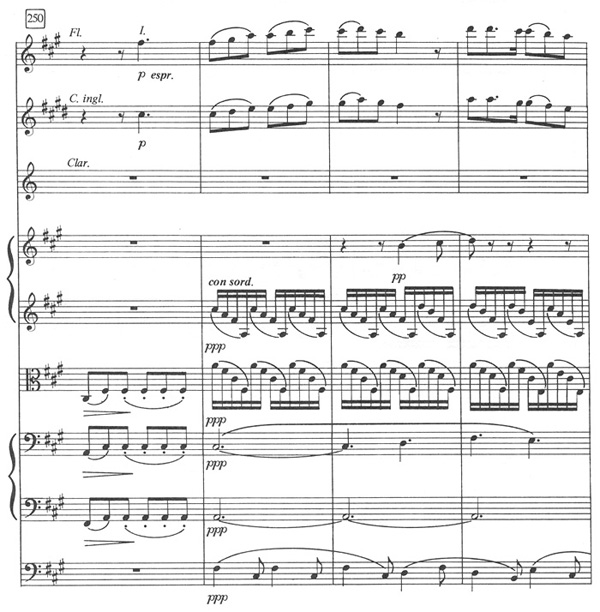
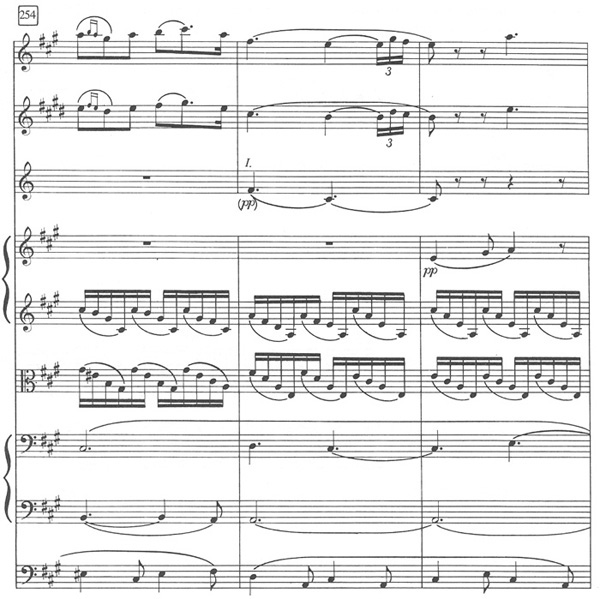
Berlioz's Treatise on Instrumentation (1844) clarifies still further the logic of his orchestral choices. He writes with regard to the English horn, for example, that its timbre is appropriate for scenes one step removed from reality—such as dreams or recollections:
Its tone, less piercing, more veiled and heavy than that of the oboe, does not lend itself so well to the gaiety of rustic melodies. Nor can it express passionate laments; tones of keen grief are scarcely within its range. Its tones are melancholy, dreamy, noble, somewhat veiled—as if played in the distance. It has no equal among the instruments for reviving images and sentiments of the past if the composer intends to touch the hidden chords of tender memories.7
Or elsewhere, in connection with the significative power of harmonics in the violins, Berlioz cites the dream-like aura they can create:
The harmonics on the other strings other than the fourth string which has a flute-like character become increasingly more delicate and soft as they rise in pitch. This, as well as their crystalline sound, makes them especially appropriate for those chords which may be called fairy-like: harmonic effects which fill our imagination with radiant dreams and conjure the most delicate images of a poetic, supernatural world.8
Taking a step back from the symbolism of Berlioz's orchestral detail, we find that he has ordered the long-range plan of this movement so that the three Trios described above recur in a progression of decreasing independence. The first Trio stands out as the most discrete of the three: the shift in tonality from F major to d minor/D major, the new thematic idea, and the changes in tempo and meter clearly mark the start of a new section.9 Similar departures from the Scherzo in both harmony and melody (a modulation to C major coincides with the entry of the horn motives) also signal the beginning of the second Trio. Here, however, the boundary-line between Scherzo and Trio is less sharply etched, because Berlioz continues the eighth-note surface rhythm of the Scherzo well into Trio 2 and also because he repeats the initial motive of the Scherzo precisely at the point where the Trio begins.
Example 4. Berlioz, Romeo and Juliet, "Queen Mab" Scherzo, mm. 495-511: the partially disguised opening border of the second Trio.
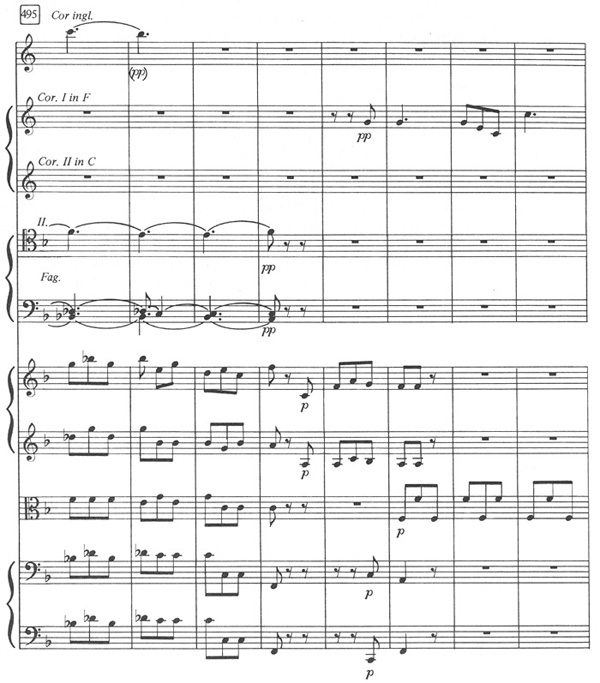
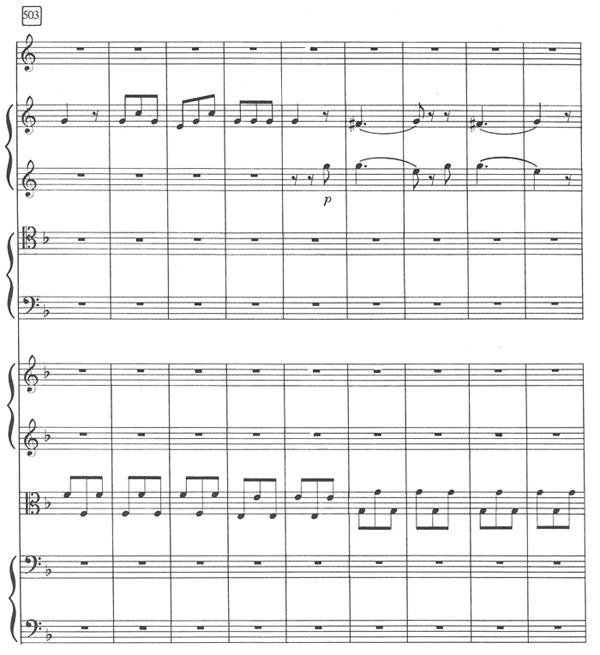
Least distinct of all is the boundary at the beginning of the third and final Trio. The gradual ritard and the decrease in dynamics make this brief Trio vague in identity. In many ways, it seems little more than a momentary slowing before Mab's frantic rush to escape the dawn.
Yet again, structural events carry programmatic implications. On a macro-level, the built-in asymmetry deriving from the changing lengths and the diminishing independence of the Trios heightens the helter-skelter feeling of Queen Mab's nocturnal visits. Locally, although the Scherzos retain palpable vestiges of rounded binary form, each Trio follows a free formal scheme:
Example 5. Berlioz, Romeo and Juliet, "Queen Mab" Scherzo. The formal scheme of the Scherzos and Trios.
| SCHERZO 1 | |||||
| A 1-57 |
A1 57-150 |
B(A) 151-254 |
B1(A) 255-357 |
CODA 357-365 |
TRANS. 365-377 |
| TRIO 1 | |||||
| C 378-394 |
C1 395-412 |
C2 413-427 |
C3 428-441 |
TRANS. 442-454 |
|
| SCHERZO 2 | |||||
| A2 454-498 |
|||||
| TRIO 2 | |||||
| D 499-685 |
|||||
| SCHERZO 3 | |||||
| A3 686-730 |
|||||
| TRIO 3 | |||||
| 731-751 | |||||
| SCHERZO 4 | |||||
| A4 752-793 |
Apparently the predictable layout of traditional dance-movement form seemed less than appropriate to dream sequences.
The confluence of program and sonority outlined in the present paper represents more than just a passing phase or chance occurrence in Berlioz's style.10 Varied applications of this same combination, raising sonority to a level of structural significance, may be found in other works, offering equally rich analytical rewards to the curious explorer.
1See, for a typical example, A.E.F. Dickinson, The Music of Berlioz (London: Faber and Faber, 1972), 146, or Hugh MacDonald, Berlioz (London: Dent, 1982), 119, where he writes, "The scherzo (La reine Mab) . . . is Berlioz's supreme exercise in light orchestral texture, prestissimo and pianissimo almost without pause. The scoring is extraordinarily inventive. . . ." Berlioz himself unwittingly contributed to this tradition. When talking about this movement, he invariably mentioned the orchestration, usually because of the performance difficulties it caused. See The Memoirs of Hector Berlioz, trans. and ed. David Cairns (London: Victor Gollancz, 1969), 311, 340.
2Even these more obvious interrelationships between the Scherzetto in the Prologue and the Scherzo movement often pass unremarked. Dickinson, The Music of Berlioz, 148, treats the Scherzetto as material heard once, i.e., as without meaningful connection to the later movement; or again, MacDonald, Berlioz, 117: ". . . the foretasted scherzo [i.e. the Scherzetto in the Prologue] is not the same as the fourth movement (except the final flourish); it is a 'scherzino' or 'scherzetto' (Berlioz used both titles) in 2-4, with the tenor soloist and semi-chorus giving a deliciously light picture of the Queen of Dreams. . . ."
3We do not know enough about the details of Berlioz's collaboration with Deschamps to gauge the extent to which the changes in the Shakespearean text are a direct reflection of Berlioz's own suggestions. It is also possible that these changes derive from the Garrick version of Romeo and Juliet upon which the tomb scene was based and which was not available to the present author for purposes of comparison.
4The Shakespeare text is taken from The Penguin Shakespeare, ed. G.B. Harrison (London: Wyman and Sons, 1937). The Berlioz is translated from the French by John Bernhoff and appears in the Kalmus miniature score of Romeo and Juliet (Kalmus Miniature Scores 502).
5This interpretation differs sharply from the usual assumption that the movement is organized in a simple Scherzo-Trio-Scherzo pattern. See Dickinson, The Music of Berlioz, 150-51. Interestingly, MacDonald comments on a "genial snore on horn and bassoons" evoking the lines "Athwart men's noses as they lie asleep" (119). He does not, however, develop this line of thought. Furthermore, in discussing the programmatic role of the Trios, we should not overlook Berlioz's own subtitle for this movement—"The Fairy of Dreams."
6The third Trio does not seem to convey any specific orchestral references, although the antiphonal exchange in strings and winds, coupled with the frequent fermatas, may possibly refer to the orchestral sound at the end of the Love Scene (see II, mm. 375-89).
7Hector Berlioz, Treatise on Instrumentation, enlarged and revised by Richard Strauss, trans. Theodore Front (Melville: Kalmus, 1948), 184.
8Berlioz, Treatise on Instrumentation, 29.
9In an interesting study of Berlioz's use of rhythm, Philip Friedheim suggests that Berlioz associated different meters with different emotional states. According to Friedheim, 3-8 signifies the impish and playful, while 3-4 (which Berlioz introduces at the start of the first Trio) expresses more intense and passionate feelings. See Philip Friedheim, "Berlioz and Rhythm," Music Review 37 (1976) 5-44.
10This specific formula (S T1 S' T2 S" T S'''), with Trios of varying length and clarity, does not appear in Berlioz's two earlier symphonies—the Symphonie fantastique and Harold in Italy. In the former work, the dance movement is organized in an ABA-plus-Coda plan, and in Harold as an S T S T-plus-S arrangement. Since Berlioz's formal schemes are always clearly attuned to the changing programmatic content of his works, this structural variety is not surprising.


